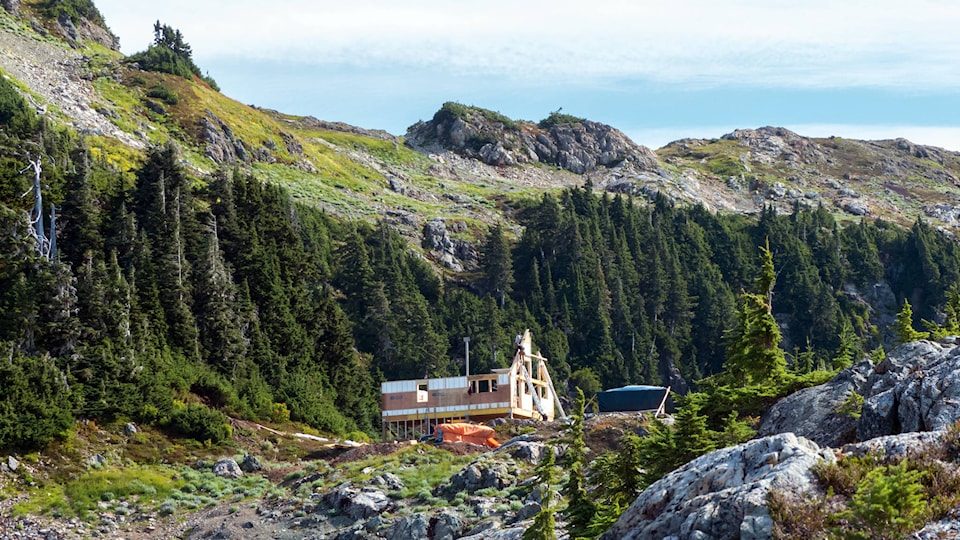Sandy McRuer
Special to the News
Getting to the alpine on Vancouver Island requires work, unless you want to take the chair lift to the top of Mount Washington. And if you want to stay overnight, it requires even more … let’s say exercise.
In addition to your lunch, water, a sweater, first aid kit, and way-finding gear, you have to carry a tent, sleeping bag, a stove, fuel, cooking utensils, etc. That’s why hiking organizations in many countries around the world have built mountain huts, so people don’t have to carry some of that extra gear. Other than old miner’s cabins that are falling down, and private ones, there is only one public cabin on Vancouver Island. And it is on the other side of Buttle Lake up in Marble Meadows, Strathcona Park.
So when I heard a hut was being built on Mount 5040, thanks to the Vancouver Island section of the Alpine Club of Canada, it piqued my interest. When I heard the outdoor club had a trip planned that went up to it, I took the opportunity and went with them. I felt badly leaving Patti behind, but the cost in joint pain for her is too much. She gets her exercise at the pool or walking. This was going to be a rigorous hike for me. We were to go in along an alternate route that had just been built. The lower parts of the trail are worn well enough that the average person would be able to follow it. But it is steep; deep forest with boulders and bluffs. In one spot there is an old step ladder, donated to the cause.
Up higher, where the forest starts to thin out and the ground cover consists of brushy mats of heather, is where one needs to rely on a ribbon line. However, if you lose the line, (like I did) pick your own line and just scramble up the rough terrain. Eventually trees thin out as you approach the tree line and you’ll be able to see a broad ridge above you. By the time I got to the top I was hearing the sounds of construction. There were a dozen men working on the hut, three or four women and even a baby, all volunteers there. Two large geodesic -dome tents, and several other smaller sleeping tents were a few meters away.
In my mind, I pictured a hut where five to six people might be crammed together. What I saw under construction was quite a bit grander than that. Looking through other huts on the Alpine Club of Canada’s website, I was impressed with how large it was.
It’s designed to sleep 12 with ample room for kitchen and living space. And the LED lights in the hut will be solar powered.
All the materials were slung up by helicopter – twelve loads, I hear.
I had lunch and hung around the hut site. It has absolutely stunning scenery. There are some incredible mountains in this part of Vancouver Island. Looking across the valley the pinnacles Nine Peaks backlit by the sun looked fierce and formidable. Clearly it cannot be scaled without ropes and climbing gear. Other mountains visible were: The Cats Ears, almost as formidable; Steamboat Mountain, full of karst topography, and Pogo Mountain, then below, a wonderful view of Cobalt Lake. Behind me Mount 5040 loomed, another 180 meters higher at 1,532.
A lot of thought went in to the location of the hut. It is on the divide between the Kennedy Valley, the Effingham Valley and the Nahmint Valley and serves a large alpine area including Nahmint Mountain. It is accessed from the Kennedy River Valley.
After Sutton Pass, take the first left and drive pretty much to the end of Marion Creek Forest Service Road. Note: there is no access by ATV or snowmobiles.
Word is getting out about the mountains in the Kennedy River Valley. I was impressed with the number of visitors. Despite a road that is clearly for 4x4s, we encountered almost a dozen others besides the dozen building the hut and the dozen in our party.
The hut will add to the diversity of things to do both in summer and winter in the region (there is good backcountry skiing too). And it will add to the economic diversity of the region.
The people who put this together are a class act. This project was very much supported by local communities including the four First Nations in the area, the Regional District, Port Alberni, the rescue squad, Mountain Equipment Co-op and the Island Coastal Economic Trust. Thanks to the efforts of all of them a wonderful resource will attract visitors in all seasons.
